
Argentina language reflects its rich history and culture. Although almost all Argentinians speak Spanish as their official language, it is not the only one. Argentina differs from other Spanish-speaking countries due to the distinctive Rioplatense Spanish dialect, which is influenced by Italian immigration and regional customs. In addition to Spanish, the nation's linguistic diversity includes regional dialects, immigrant languages, and indigenous languages, representing its multicultural past.
The linguistic diversity provides a window into Argentina's identity, whether you're traveling through areas where Guaraní or Mapudungun are still spoken or Buenos Aires, where Rioplatense Spanish is the predominant language. Argentina's communication is as diverse and rich as its landscapes because every language carries a bit of its history and culture.
Key tips box
| Spanish is the dominant language in Argentina, spoken by nearly all of the population. The Rioplatense dialect, characterized by voseo (using "vos" instead of "tú") and unique pronunciation (sheísmo), sets it apart from other Spanish-speaking regions. Linguistic diversity enriches Argentina's culture, with Italian as the second most spoken language, alongside indigenous languages like Quechua and Guaraní. |
Spanish is the official language of Argentina, spoken by the vast majority of the country's population. The history of Spanish in Argentina dates back to the early 16th century when Spain colonized the region. The language was brought by Spanish missionaries and conquistadors who looked to spread Christianity and establish Spanish rule. Native languages were gradually displaced by Spanish as the dominant language over time.
The adoption of Spanish as Argentina's official language played a crucial role in unifying communication across the country. After declaring independence from Spain in 1816, Argentina retained Spanish as its primary language for government, education, and media. This choice promoted national unity and cultural advancement by fostering a common linguistic identity among Argentina's various regions and populations.
While Spanish dominates, Argentina's linguistic landscape is far more diverse, reflecting its rich history of immigration and indigenous cultures.
Italian has had a profound impact on Argentine Spanish, particularly due to large-scale immigration in the late 19th and early 20th centuries. This influence is evident in:
Vocabulary
Many Italian words have been incorporated into everyday Argentine Spanish.
| Word | Description |
| Birra | An informal term for "beer," derived from the Italian birra. |
| Chao | Friendly greeting meaning "bye," from Italian ciao. |
| Fiaca | Slang for laziness or a lazy person, from Italian fiacca. (sluggishness) |
| Laburar | The informal term for "to work," from Italian lavorare. |
| Milanesa | A popular dish made with breaded meat, derived from Milanese. |
| Mina | An informal word for "woman," originating from Lombard dialect mina. |
| Mortadela | Food item similar to bologna, from Italian mortadella. |
| Mufa | Slang for "bad luck," derived from Italian muffa (mildew). |
| Pibe | Informal word for "kid" or "boy," from Italian dialect pive (piccino). |
| Salute | Used as a greeting or toast, meaning "health," from Italian saluti. |
| Anchoa | Anchovy, derived from Genoese dialect ancioa. |
| Contorno | Side dish, directly borrowed from Italian contorno. |
| Fungi | Mushroom, adapted from Italian fungo. |
| Gafo | Slang for "stupid," originating from Italian cafone (peasant). |
| Pasticho | A lasagna-like dish, derived from Italian pasticcio. |
Pronunciation
One of the most distinctive characteristics of Rioplatense Spanish, particularly in Buenos Aires, is its distinct intonation. It is frequently said that this melodic quality is similar to Southern Italian speech patterns, such as Neapolitan. The large-scale Italian immigration to Argentina in the late 19th and early 20th centuries is what caused the influence. Millions of Italians moved to cities like Buenos Aires, where their speech patterns organically merged with the regional dialect of Spanish to produce a rhythmic and expressive style.
Cultural Expressions: The Development of Lunfardo
Lunfardo is a colorful slang that emerged in Buenos Aires during the late 19th century. It originated in the working-class neighborhoods and was heavily influenced by Italian immigrants who brought their language and culture to Argentina. Over time, Lunfardo evolved into a mix of Spanish, Italian, and other European languages like French and Portuguese, creating a unique linguistic phenomenon.
Despite the dominance of Spanish, several Indigenous languages continue to be spoken in Argentina. Like in other latinoamerican countries such as México, Colombia and Perú:
As of 2025, at least fourteen indigenous languages are still spoken in Argentina, though this number has decreased significantly from the more than thirty-five languages that existed before Spanish colonization.
Other European languages have also contributed to Argentina's linguistic diversity:
In recent years, English has gained increasing prominence in Argentina, especially among younger generations in urban areas. This trend is driven by the need for international communication in business and education and exposure to English-language content through movies, music, and the Internet.
While not an official language, English proficiency is increasingly valued in professional settings and urban culture, reflecting Argentina's engagement with global trends and international markets.

The pronunciation of "ll" and "y" as [ʃ] (similar to "sh" in shoe) or [ʒ] (similar to "zh" in measure) is a hallmark of Rioplatense Spanish, particularly in Buenos Aires. This phenomenon, known as yeísmo rehilado, gives the dialect its distinctive sound. Examples include:
Argentinian Spanish has a sing-song quality influenced by Italian immigration, making it more expressive than other Spanish dialects. Key features include:
Instead of "tú," Rioplatense Spanish uses "vos" for informal second-person singular pronouns, affecting verb conjugations:
Rioplatense Spanish modifies verb endings for informal speech:
Lunfardo slang adds a rich layer to Argentina Spanish, blending Italian, Spanish, and other influences:
Argentine Spanish uses distinct terms compared to Castilian Spanish:
| Object | Spain | Argentina |
| Bus | Autobús | Colectivo |
| Pen | Bolígrafo/Boli | Lapicera |
| Apartment | Piso | Departamento |
| Cell Phone | Móvil | Celular |
| Computer | Ordenador | Computadora |
| Car | Coche | Auto |
| Jacket | Chaqueta | Campera |
| Straw | Pajita | Bombilla |
| Glasses | Gafas | Anteojos |
| Sneakers | Zapatillas | Zapatillas deportivas |

Rioplatense Spanish, also known as River Plate Spanish, is a unique variety of Spanish spoken predominantly in the Río de la Plata Basin, which includes Buenos Aires, Montevideo, and surrounding areas. It is characterized by distinctive pronunciation, grammar structures, and vocabulary influenced by historical immigration and cultural development. This dialect is widely recognized for its melodic intonation and incorporation of Lunfardo slang, making it one of the most expressive forms of Spanish.
The origins of Rioplatense Spanish date back to the 16th century during the colonization of the Río de la Plata region by the Spanish Empire. The first settlement in Buenos Aires was established in 1536 by Pedro de Mendoza but was abandoned due to conflicts with indigenous tribes. The region was later resettled in 1580, becoming a key colonial hub. During this period:
The most significant transformation of Rioplatense Spanish occurred during the late 19th and early 20th centuries when millions of European immigrants arrived in Argentina and Uruguay.
The rapid urbanization of Buenos Aires in the late 19th century created a melting pot of cultures. This led to:
Rioplatense Spanish employs vos instead of tú for informal second-person singular pronouns, changing verb conjugations:
The pronunciation of "ll" and "y" as [ʃ] or [ʒ] gives Rioplatense Spanish its unique sound:
Lunfardo slang adds a colorful layer to Rioplatense Spanish, blending Italian, Spanish, and other influences:
Tango lyrics often incorporate Lunfardo slang and emotional expressions. These lyrics not only reflect the melodic intonation characteristic of Rioplatense speech but also embody the dramatic storytelling typical of the region's culture. This blend of language and music has immortalized Rioplatense Spanish, making it a symbol of Argentine identity.
Rioplatense Spanish is also influenced by the rural traditions of Argentina's gauchos. Words such as mate (a tea-like drink) and estancia (ranch) are deeply rooted in gaucho life, contributing to the dialect's unique vocabulary. Gaucho poetry often employs rhythmic speech patterns that mirror the intonation of Rioplatense Spanish, further enriching its cultural significance.

To effectively learn Argentine Spanish, start by focusing on voseo, the unique use of vos instead of tú for informal second-person singular pronouns. Unlike traditional Spanish, voseo follows simplified conjugation rules, making it easier to grasp. For example:
Additionally, familiarize yourself with the exception for the verb ser, which conjugates as sos (you are) instead of the standard eres. Practice these forms regularly, as they are essential for everyday communication in Argentina
Watch Argentine films or listen to tango music to get accustomed to pronunciation and rhythm. This exposure helps internalize the melodic intonation and unique vocabulary of Rioplatense Spanish.
Familiarize yourself with Argentine gestures and expressions. Pay attention to non-verbal cues like lip-pointing and dramatic shrugs, which are integral to communication. Understanding these cultural nuances will enhance your interactions with locals.
Argentina's linguistic landscape is a vibrant tapestry woven from a variety of influences. Voseo usage, colourful Lunfardo slang, and melodic intonation define this unique dialect of Spanish, which was influenced by Italian immigration and regional customs. In addition to reflecting Argentina's rich cultural legacy, Rioplatense Spanish acts as a link between the nation's colonial past and contemporary identity.
For both language learners and culture lovers, learning about Argentine culture through its language is a fulfilling experience. Learning Rioplatense Spanish opens the door to comprehending Argentina's dynamic identity, whether through becoming fluent in the unique slang of Buenos Aires or losing oneself in the poetic expressions of tango music.